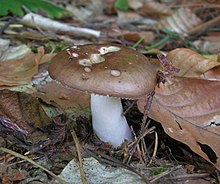| Russula integra | |
|---|---|

| |
| Scientific classification | |
| Domain: | Eukaryota |
| Kingdom: | Fungi |
| Division: | Basidiomycota |
| Class: | Agaricomycetes |
| Order: | Russulales |
| Family: | Russulaceae |
| Genus: | Russula |
| Species: | R. integra |
| Binomial name | |
| Russula integra (L.) Fr. | |
| Synonyms | |
List
| |
Russula integra, commonly known as the entire russula, is a species of mushroom. The fungus stems from the huge genus of Russula. It is found in conifer forests across Europe and throughout North America. The fruiting body is mildly flavoured with a slight cashew-like taste and dense flesh. It is edible and most commonly consumed in Central Europe.
Description
The cap is almost shaped like a sphere at first, and soon becomes flattened or depressed; it is 6–12 cm (2.4–4.7 in) broad. The cuticle is shiny, varies in color, but is usually brown and tinged with violet, purple, yellow, or green. The gills are thick, widely spaced, easily crumbled into small pieces, white at first and then turns bright yellow eventually. The stipe is thick and white, but stains yellow or russet with age; it measures 5–12 cm (2.0–4.7 in) long and 2–3 cm (0.79–1.18 in) thick. The flesh is white, very firm, and has a mild flavor. The spore print is yellow-ochre, broadly elliptical, and has amyloid warts.
Edibility
The authors of The Great Encyclopedia of Mushrooms said that the species has a crunchy texture and tastes nutty. It is popular to eat in Northern and Central Europe. In Romanian, the mushroom is called pâinişoară ("little bread") due to its edibility and perceived taste and texture. David Arora said that the species is good when it is young. There are species with unknown edibility that look similar to this species. According to an 1878 study, poisoning from this species used to be frequent, but is now rare. The study concluded that long cooking gets rid of its poisonous properties, but that rapid culinary processes does not such as roasting.
Similar species
Russula mustelina is similar, with a brown cap, white stalk, yellow spores, and firm flesh.
Habitat
David Arora said that species is widely distributed and can commonly be found scattered under conifers. and the authors of The Great Encyclopedia of Mushrooms said that the species can commonly be found in spruce forests or fir forests in the mountains. The species is
Species of fungus| Russula integra | |
|---|---|
| Gills on hymenium | |
| Cap is convex or depressed | |
| Hymenium is adnate or free | |
| Stipe is bare | |
| Spore print is yellow | |
| Ecology is mycorrhizal | |
| Edibility is edible but not recommended | |
rare in New York and can be found there in August.
References
- ^ New York State Museum (1907). Bulletin of the New York State Museum, Issues 112-117. The University. p. 93.
- ^ Davis, R. Michael; Sommer, Robert; Menge, John A. (2012). Field Guide to Mushrooms of Western North America. Berkeley: University of California Press. p. 110. ISBN 978-0-520-95360-4. OCLC 797915861.
- ^ Polese, Jean-Nari; Lamaison, Jean Louis (1999). The Great Encyclopedia of Mushrooms. Chanterelle Translations, London. p. 43. ISBN 3-8290-1728-6.
- ^ Arora, David (1986). Mushrooms Demystified: A Comprehensive Guide to the Fleshy Fungi. Ten Speed Press. p. 101. ISBN 978-0-89815-169-5.
- DEX Online
- Multiple authors (1878). Cyclopædia of the practice of medicine, Volume 17. W. Wood and Company. p. 941.
External links
- [REDACTED] Media related to Russula integra at Wikimedia Commons
| Taxon identifiers | |
|---|---|
| Russula integra | |
| Russula adulterina | |
| Agaricus integer | |